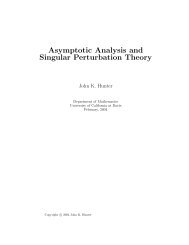PHLST WITH ADAPTIVE TILING AND ITS APPLICATION TO ...
PHLST WITH ADAPTIVE TILING AND ITS APPLICATION TO ...
PHLST WITH ADAPTIVE TILING AND ITS APPLICATION TO ...
You also want an ePaper? Increase the reach of your titles
YUMPU automatically turns print PDFs into web optimized ePapers that Google loves.
2 ZHIHUA ZHANG <strong>AND</strong> NAOKI SAI<strong>TO</strong><br />
Subsequently this component is subtracted from the original local piece to obtain<br />
the residual. Since the boundary values of the residual vanish, its Fourier sine series<br />
expansion has quickly decaying coefficients. Consequently, <strong>PHLST</strong> can distinguish<br />
intrinsic singularities in the data from the artificial discontinuities created by the<br />
local windowing. Combining this ability with the quickly decaying coefficients of<br />
the residuals, <strong>PHLST</strong> is also effective for image approximation, which was demonstrated<br />
using both synthetic and real images in [11]. Of critical importance in<br />
<strong>PHLST</strong> is how to tile an input image. As discussed in [11], there is no need to<br />
divide a smooth region of a given image into a set of smaller blocks, and in fact,<br />
that is wasteful due to the storage of the corner and boundary information in each<br />
block. In [11], however, Saito and Remy did not propose any automatic tiling algorithm<br />
for <strong>PHLST</strong>. In this paper, we will propose the <strong>PHLST</strong> equipped with an<br />
adaptive tiling algorithm for efficiently approximating given input images. We will<br />
demonstrate the effectiveness of the <strong>PHLST</strong> with the adaptive tiling algorithm for<br />
approximating Antarctic remote sensing images. Since such remote sensing images<br />
often consists of a large smooth part and smaller singular regions represented by<br />
snow ripples, fractured ice, and coastlines, our proposed <strong>PHLST</strong> algorithm is more<br />
effective to approximate such images then the <strong>PHLST</strong> with the uniform tiling as<br />
was done in [11].<br />
We also would like to mention the importance of efficiently approximating and<br />
compressing such Antarctic remote sensing images. The current world is facing<br />
a series of unprecedented major global environmental problems caused by global<br />
warming. In the 2007 Fourth Assessment Report (AR4) by the Intergovernmental<br />
Panel on Climate Change (IPCC) of the United Nations, it is indicated that most<br />
of the observed warming over the last 50 years is likely to have been due to the<br />
increasing concentrations of greenhouse gases produced by human activities such<br />
as deforestation and burning fossil fuel. In polar regions, warming will be expected<br />
to be strongest and cause the retreat of glaciers and sea ices, even the melting of<br />
ice sheets. Partial deglaciation of the West Antarctic ice sheet could contribute 4-6<br />
meters or more to sea level rise. This will be a big disaster for human being. A<br />
good approach to observe and analyze the change of ice structures is to compare<br />
remote sensing images of Antarctica taken at difference times. Such an endeavor<br />
forces one to store a huge amount of remote sensing data. In order to save storage<br />
space, one needs to develop a new image compression algorithm that can efficiently<br />
preserve intrinsic features (or singularities) of Antarctic remote sensing images with<br />
small storage costs.<br />
This paper is organized as follows. In Section 2, we recall the concept of <strong>PHLST</strong>.<br />
In Section 3, in order to measure the local smoothness of an image, we introduce<br />
the concept of local Besov indices and discuss the relation between local Besov<br />
indices and global Besov indices. Based on these indices, in Section 4, we derive a<br />
fundamental principle of adaptive tiling. In Section 5, we obtain a precise estimate<br />
of the nonlinear approximation error of the target function using <strong>PHLST</strong> with<br />
adaptive tiling. It is clear that the obtained nonlinear approximation order using<br />
<strong>PHLST</strong> with adaptive tiling is much better than that using <strong>PHLST</strong> with uniform<br />
tiling. InSection6, weapplyourresearchonnonlinearapproximationusing<strong>PHLST</strong><br />
with adaptive tiling to Antarctic remote sensing image approximation.
















